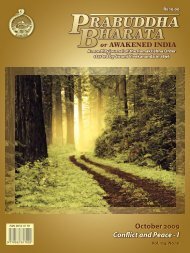According
August 2009 - Advaita Ashrama
August 2009 - Advaita Ashrama
- No tags were found...
Create successful ePaper yourself
Turn your PDF publications into a flip-book with our unique Google optimized e-Paper software.
complished by worshipping someone who is not<br />
bound by nature or maya. There is an intense struggle<br />
between the animal man and the spiritual man,<br />
until he finally cuts his way out to freedom. Thus<br />
we have the seer of truth and seekers of truth stumbling<br />
through internal roadblocks until they see<br />
‘not as through a glass darkly’ but ‘face to face’. The<br />
mirror of the mind must be polished so that the<br />
Truth, the one Reality can be experienced: ‘The<br />
Atman in all beings does not manifest Himself to<br />
the eyes or the senses, but those whose minds have<br />
become purified and refined realize Him. Beyond<br />
all sound, all sight, beyond form, absolute, beyond<br />
all taste and touch, infinite, without beginning and<br />
without end, even beyond nature, the Unchangeable;<br />
he who realizes Him, frees himself from the<br />
jaws of death’ (2.169–70).<br />
A Vedantic Reading<br />
What struck me as odd when I first read the Republic,<br />
and strikes me as anomalous even after many<br />
readings over the years, is the feeling of déjà vu, of<br />
easy familiarity. The line of argument is consistent<br />
with the Upanishads and other sacred Indian literature.<br />
We are all victims of the darkness of ‘tamas’.<br />
As Swamiji says, our sense of freedom is an illusion.<br />
We are bound by the shackles of sense perception<br />
and we mistake shadows for reality. And this, to<br />
echo Swamiji, is maya. Plato never uses the term<br />
‘maya’, but the description of ignorance and delusion<br />
that he gives is similar in meaning.<br />
In Jnana Yoga, Swamiji explains maya and<br />
illusion:<br />
PB August 2009<br />
Plato’s Allegory of the Cave: A Vedantic Reading 35<br />
Because we talk in vain, and because we are satisfied<br />
with the things of the senses, and because we<br />
… as it were, cover the Reality with a mist … we<br />
get the idea that the cause of our ignorance is a<br />
kind of mist that has come between us and the<br />
Truth (2.88).<br />
As no man can jump out of his self, so no man<br />
can go beyond the limits that have been put upon<br />
him by the laws of time and space (2.91).<br />
Time, space and causation are like the glass<br />
through which the Absolute is seen, and when<br />
it is seen on the lower side, It appears as the universe<br />
(2.130).<br />
We may remember that the prisoners have been<br />
in the underground den since birth and as they are<br />
chained, they cannot even move their heads, much<br />
less go beyond the space limitations of the cave.<br />
Interestingly, for Swamiji, everything that comes<br />
to us not only through the senses and mind but<br />
also through the intellect is limited. For Plato, the<br />
intellect, through a process of dialectic and reasoning,<br />
can reach Reality. He makes no distinction<br />
between secular and sacred knowledge. His<br />
ideal state has elements that would not be acceptable<br />
to the jnani—such as the emphasis on the art<br />
of war—but in terms of the transition from ‘becoming’<br />
to ‘being’ his ideas echo ancient Indian<br />
thought. Volumes have been written about the concepts<br />
of ‘nothingness’, ‘becoming’, and ‘being’ from<br />
Hegel to Sartre. For the present, we could simply<br />
consider it as ‘realizing one’s full potential’.<br />
To quote Swamiji again: ‘Man feels, consciously<br />
or unconsciously, that he is bound; he is not what<br />
he wants to be. It was taught to him the very moment<br />
he began to look around. That very instant<br />
he learnt that he was bound, and he also found that<br />
there was something in him which wanted to fly beyond,<br />
where the body could not follow, but which<br />
was yet chained down by this limitation’ (2.103).<br />
The journey out of the limitation of the cave is a<br />
path that leads a prisoner from nothingness to ‘being’.<br />
Initially, it is difficult for him to accept that the<br />
world of shadows, of sight, is relative and therefore<br />
not real. He finds it difficult to accept a reality which<br />
transcends sense perception. Empirical thought rejects<br />
any fact that cannot be seen and verified. So<br />
long as the prisoners are in the cave, the true reality<br />
for them can only be the shadows they see and the<br />
echoes they hear. The transition from the darkness<br />
of the cave to the blazing light of the sun is through<br />
a twilight zone. Swamiji explains a portion of the<br />
ancient Upanishads: ‘There is another heaven called<br />
the Gandharva, in which … as a man sees his own<br />
reflection in the water, so is the Reality seen there.<br />
The highest heaven, of which the Hindus conceive is<br />
475
















